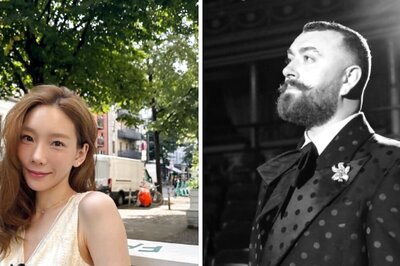
views
What is a lanky body?
A lanky body means someone is tall and skinny. Someone who is lanky is very tall and lean with long, gangly arms and legs. They typically have a low body fat and muscle mass percentage, and in some cases, may be underweight for their height. Due to their thin frame and long limbs, people who are lanky can appear uncoordinated and like they move awkwardly or ungracefully. Celebrities with a lanky body: Kevin Durant, Nicholas Braun, Bill Skarsgård, Snoop Dogg, Elizabeth Debicki, Jourdan Dunn A lanky body is usually caused by genetics. It can also be influenced by someone’s metabolism, exercise habits (i.e., burning a lot of calories), and diet (i.e., not eating enough calories or protein).
What body type is considered lanky?
A lanky body is often related to the ectomorph body type. The ectomorph body type is one of the 3 common body types (the other 2 are mesomorph and endomorph). The ectomorph body type is characterized by a slender frame, narrow hips and shoulders, and low muscle mass. People with this body type often have a fast metabolism, which can make it harder for them to gain fat and muscle. The 3 body types are often used by fitness trainers to develop exercise and diet plans that work best for each type. Can you change your body type? Your body type is mostly determined by your genetics and bone structure, so you can’t get a different body type. However, it is possible to alter your proportions through diet and exercise. If you want to get a more muscular and filled-out look, we’ll go over some diet and exercise tips in the section below.
How to Look Less Lanky
Do weight training exercises to help build muscle. According to personal trainer Brendon Rearick, the best way to increase muscle mass is to “lift heavy,” which just means choosing a weight that starts to feel difficult to lift toward the end of your repetitions for an exercise. He suggests focusing on compound lifts, which work multiple muscles at a time, and aiming to complete 8 to 12 reps of each exercise. Compound lifts include squats, bench presses, deadlifts, push-ups, planks, lunges, rows, and ab wheel rollouts, says Rearick. Train your major muscle groups (back, arms, legs, chest, shoulders, and abs) at least 2 times per week, allowing each group to rest for 1 day before you work them out again. Increase your weights when you can easily get to the end of your reps, says certified personal trainer Pete Cerqua. When will I see muscle growth? “If you’re training consistently and eating enough protein,” says exercise and wellness specialist Souad Gharib, “you’ll start seeing small changes in 4 to 6 weeks.”
Eat a diet rich in protein, healthy fats, fruits, and veggies. A healthy diet is just as important for building muscle as exercise. NASM-certified personal trainer Laura Flinn says, “Foods that will help build muscle overall are lean protein such as chicken, turkey, eggs, lean beef, fish, whey protein powder, and Greek yogurt.” She also recommends getting plenty of complex carbs and healthy fats like “sweet potato, brown rice, vegetables, fruits, avocados, nuts, and olive oil.” As a general guide for building muscle, Cerqua recommends getting about 50% protein, 40% carbohydrates, and 10% fat in each meal and snack. Certified fitness coach Danny Gordon advises using an app like MyFitnessPal to help calculate how much protein, carbs, and other nutrients you need to intake to achieve your goals. If you’re vegetarian or vegan, beans, lentils, tofu, tempeh, and nuts are all great sources of protein.
Eat enough calories each day. If you have a high metabolism or struggle to gain weight and muscle, Gharib says you simply need to eat more. Use an online calorie calculator to find out how many calories you need to be eating each day. If you’re underweight and trying to gain weight, aim to eat 300 to 500 extra calories each day. For instance, snack on foods that are high in protein and healthy fats, like nuts, seeds, Greek yogurt, and cheese.
Improve your posture with stretches and exercises. The way you hold your body can contribute to a lankier appearance. If you notice yourself slouching often, take steps to improve your posture. For instance, physical therapist Eric Christensen suggests doing doorway pec stretches, resistance rows, and resisted lat pulldowns to help strengthen your posture. Yoga therapist and instructor Elaine Oyang says doing yoga is a great way to gain awareness of your body to help improve your posture, too. When exercising, Flinn says to “make sure your shoulders are rolled back, tummy is tight, and the exercises are performed correctly.” While at work or sitting at a desk, Flinn recommends “sitting straight with your shoulders rolled back.” She says, “Your eyes should be levelled with the middle or slightly higher than the middle of your screen,” and your chair should provide lumbar support.
Develop better balance through exercises and yoga poses. People with a lanky body type can feel like their movements are clumsy or awkward. To help you feel more balanced and stable, Dr. Alex Robles, a NASM-certified personal trainer, suggests doing single-leg training exercises like lunges and split squats. Taekwondo expert Julee Peck Jones says lots of yoga poses, like the tree pose, “are great ways to improve your balance,” too.
Improve your coordination with activities like yoga, dance, and sports. Physical activities like yoga, pilates, dancing (ballet, hip-hop, etc.), sports (basketball, soccer, etc.), and martial arts help you become more aware of your body to improve your coordination, as well as your balance, strength, and flexibility. Consider taking regular classes to appear less lanky and help boost your confidence. As a plus, these physical activities are fun and a great way to socialize and meet new people.
What does skinny fat mean?
Skinny fat refers to someone with a healthy weight but high body fat. Someone who is “skinny fat” has an average BMI) but a high body fat percentage and low muscle mass percentage. In other words, they look thin while having a high body fat percentage and little muscle tone. What causes skinny fat? Being skinny fat can be genetic. It can also be caused by not getting enough cardio and strength training exercise, and eating a diet high in fats and sugars. Are there risks of being skinny fat? Having a high percentage of body fat can increase the risk of developing diabetes, high blood pressure, high cholesterol, and heart disease. Note: Being skinny fat isn’t a medical diagnosis and doesn’t imply anything about your health. However, it is always a good idea to increase your muscle mass and lose excess fat to be healthier.
Frequently Asked Questions
Is lanky an insult? “Lanky” is usually seen as a neutral term that simply describes someone who is tall and skinny. However, some people say it as a compliment, and people who have a lanky body might view it as complimentary. On the other hand, some people might find being called “lanky” insulting, especially if they’re sensitive about their body. To be on the safe side, it’s best to avoid commenting on someone’s body and calling them lanky, even if you mean it as a compliment. If you want to compliment someone, focus on praising their personality or skills. It’s important to remember that there’s nothing wrong with having a lanky body type. There’s no right or wrong way to have a body.
Is lanky the same thing as skinny? No, being lanky is not the same thing as being skinny. People who are lanky are thin, but they’re specifically tall and have long limbs. Being skinny simply refers to having a low percentage of body fat, regardless of whether you’re short, average height, or tall.
Does being lanky go away with age? People who are lanky may appear less lanky as they age. In general, as you age, body fat increases and your height decreases. Your metabolism gradually slows with age, too, which can contribute to weight gain.



















Comments
0 comment